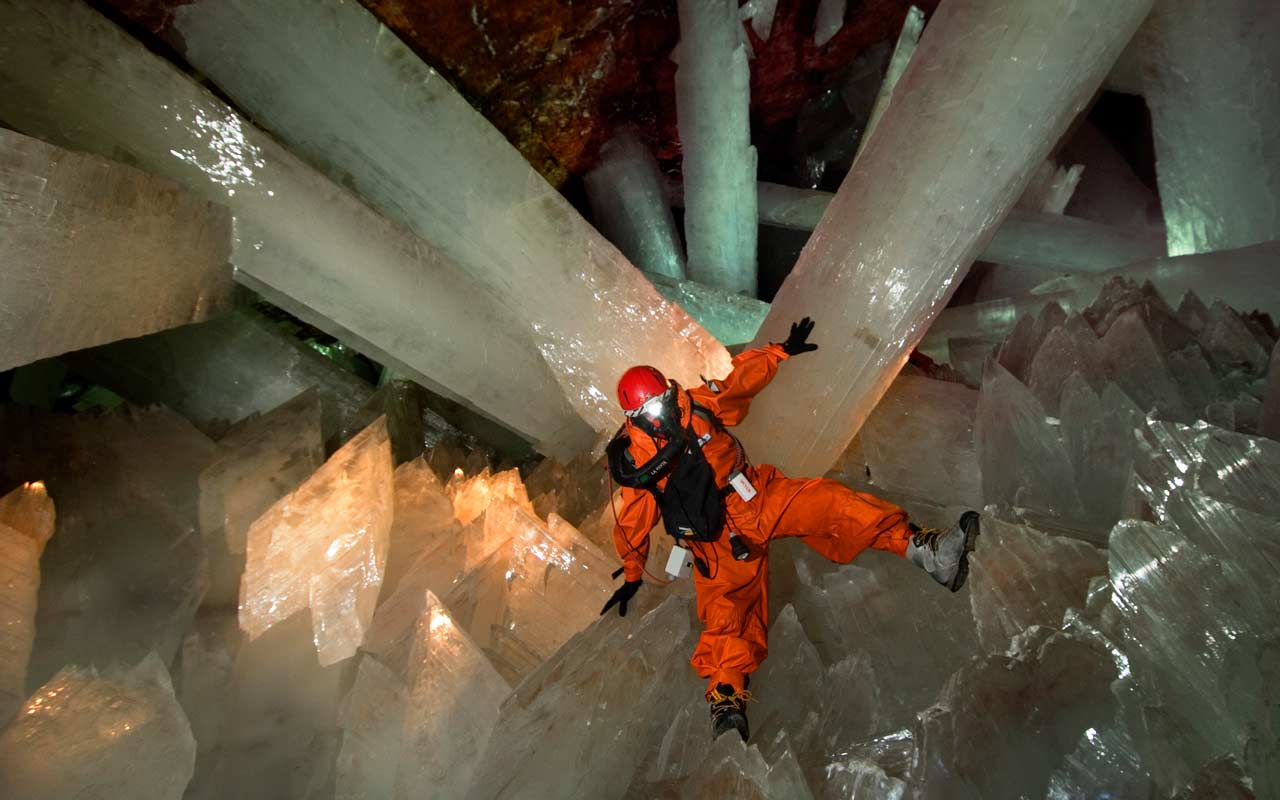How the crystals were able to grow so big.
Its walls studded with crystal “daggers,” the Cave of Swords is closer to the surface, at a depth of nearly 400 feet (120 meters). While there are more crystals in the upper cave, they are far smaller, typically about a yard (a meter) long.
Nearly the Size of a Basketball Court
Deep in the Naica Mine, located in northern Mexico, many limestone caverns adorned with large crystal growths of gypsum have been discovered by miners in the past, who were drilling for lead and silver. In the year 2000, an amazing discovery occurred when two brothers unknowingly drilled into a cave and were presented with a beautiful sight: the world’s largest gypsum crystals ever seen, reaching 11 meters in length and around a meter thick. The air in the cave has 100% humidity, while the temperature sits at 45 degrees Celsius.
Intolerable for humans, but ideal for these astounding crystals.

The Naica Mine is located over an intrusion of magma and this is what makes the temperature in the cave so hot. The crystals that were found here in what is now known as the Cave of Crystals, or Cueva de los Cristales to the locals, are the largest ever discovered and shed light onto crystal growth processes.
![]()
These giant crystals needed very specific conditions to be able to grow as large as they have. The cave in which these crystals are found was filled with water for thousands of years, and the crystals are thought to have formed extremely slowly – so slowly, that they cannot recreate the process in a lab. A geology professor from Norway, Stein-Erik Lauritzen, is conducting research on how old the crystals may be, by collecting samples to date them. His best guess so far is that the oldest crystal may have begun to form about 600,000 years ago.

Scientists specializing in crystallography such as Juan Garcia-Ruiz, from the University of Granada, Spain, have done many experiments trying to determine the conditions that allowed the crystals to form so perfectly and of course become so large. Lab experiments with varying degrees of saturation and temperature have been studied to determine what the conditions were for formation.
The temperature is thought to have remained constant throughout growth at about 58 degrees Celsius, while the water that was supersaturated with calcium sulfate began to stack together to form selenite crystals, a form of gypsum. Other caves with smaller formations did not have these ideal conditions and the temperature in them fluctuated over time, not allowing for constant uninterrupted growth.
Around 1985, the water table was lowered by the miners at Naica as they unknowingly drained the cave. If this had not occurred, the crystals would still be growing today. The selenite formations in the Cave of Crystals are very soft and can break easily if disturbed.
Even a fingernail will scratch these massive crystals. Due to the intense heat and humidity, visitors must wear protective gear like the usual headlamp and boots, but also including an oxygen mask and ice packs that are sewn into pockets all over a jumpsuit.
:max_bytes(150000):strip_icc()/gems-naica-mine-crystal-cave-mexico-CRYSTALCAVE0917-1ad418e4763141ea9cb0584964f4581c.jpg)
Now that the crystals are high and dry and their growing process is over, other research is being undertaken based on their formation, and scientists search for microbes that may thrive in this environment, as well as pollen to be able to determine past environmental conditions. This cavern is not only beneficial to science and discovery, but also simply as a wonder of the world we live in.
The company that owns the mine claims it would like to preserve and protect this amazing place, but the outlook appears uncertain. Now that the cave is devoid of water, the crystals have nothing to support them, and may crack under strain and gravity.

Atmospheric gases can get in and affect the crystals’ appearance. A steel door has been installed at the entrance to the mine, but this is a meagre barrier, not to mention being so close to the violent activities of drilling and explosives used in the mines.
This discovery will certainly go down in history, but its time may be short lived in its underground sanctuary. Like many things that have occurred over the immense history of our planet, this cave environment is constantly changing and we will have to enjoy its existence while we can.
News
Brad Pitt’s Unfortunate News. The Legendary Actor Himself Made The Announcement
Brad Pitt has informed his followers about his latest health condition. The well-known actor has shown that he has a problem with identifying people’s faces. He suspects…
(N) Solange Breaks Silence: Jay Z’s Shocking Ban on Beyonce’s Communication with Her Revealed
In a recent interview, Solange Knowles, sister of pop icon Beyoncé, has divulged details about Jay Z, Beyoncé’s husband, allegedly prohibiting her from speaking to her own…
(N) Shocking Lawsuits: Jaguar Wright Exposes Jay-Z And Beyoncé’s Hidden Truths
Jaguar Wright is revealing explosive allegations against Jay-Z and Beyoncé. Find out why they could be facing lawsuits and learn more about the shocking claims in this…
(N) Warwick Davis brings his wife Samantha and children to the screening of Disney+ series Willow as he reprises his role 34 years on
Warwick Davis is reprising his role as Willow Ufgood 34 years on for a new Disney+ series. And the actor, 52, brought his wife Samantha, 51, along with his daughter…
(N) BLUE IVY runs to her BOYFRIEND after getting the pregnancy test frm her FATHER.
BLUE IVY runs to her BOYFRIEND after getting the pregnancy test frm her FATHER. Today, we have an incredible story that will keep you on the edge…
(N) “pray for Beyoncé” DOCTOR Reveals her condition keeps getting WORST. only God can help her now.
In the face of adversity, diverse beliefs converge on a common ground – the power of prayer. Regardless of faith or background, let us collectively channel our…
End of content
No more pages to load











